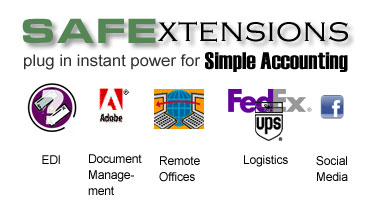This is where Simple Accounting cleans house. Since Simple Accounting updates all accounts in real time, this program has no effect on the balances of any accounts and is not critical to the accuracy of any reports in the program. However, this program is needed to perform the following important functions:
The current accounting period and/or the current accounting year, are incremented.
Period-to-date totals are set to zero for the following main data files:
Customers
Vendors
Employees
Products
Product Types.
If this is the last period in the year, the Year To Date totals are reset as well.
All transactions are removed from the transaction history file which are older than the save history days specified in Setup Global Options. Exceptions to this are outstanding invoices from vendors and to clients. These are not removed from the system until they are zeroed out through a transaction entry.
 PERIOD UPDATE DOES NOT MEAN PERIOD CLOSED! We think it bears repeating: running this procedure does not Close the accounting period. In fact, there is no period close function in Simple Accounting. You can go back and make entries to prior periods any time you like, so long as the Period is not locked.
PERIOD UPDATE DOES NOT MEAN PERIOD CLOSED! We think it bears repeating: running this procedure does not Close the accounting period. In fact, there is no period close function in Simple Accounting. You can go back and make entries to prior periods any time you like, so long as the Period is not locked.
WHEN TO UPDATE
Usually you will perform this function after you have finished performing any activities that update the general ledger on the last day of the accounting period to be closed. For most businesses, this is the last day of the calendar month.
You should not run this program before the end of the month. Though it is not possible to throw your books out of balance, it is possible to zero out period-to-date or year-to-date totals prematurely. If this happens, you should run the Retotal function from Security Extensions in order to make certain the Month To Date and Year To Date totals for your Customers, Vendors and Products is correct.
You should ALWAYS make a complete backup of your Simple Accounting data before running a Period Update!
 THE THIRTEENTH PERIOD Simple Accounting can utilize up to ninety nine accounting periods per year, although the default is thirteen. This is a standard accounting practice in many businesses but if you are new to bookkeeping you may want to keep it in mind. It is often necessary to make entries after the end of the year but which are nevertheless part of the accounting year. These entries are not part of the twelfth period and would skew the results of that month if entered there. These entries are usually adjustments to the year end financials and these entries cannot be made until after the end of the fiscal year, simply because their numbers are not known. The thirteenth period is used for these entries even though you enter them into the G/L, strictly speaking, next year.
THE THIRTEENTH PERIOD Simple Accounting can utilize up to ninety nine accounting periods per year, although the default is thirteen. This is a standard accounting practice in many businesses but if you are new to bookkeeping you may want to keep it in mind. It is often necessary to make entries after the end of the year but which are nevertheless part of the accounting year. These entries are not part of the twelfth period and would skew the results of that month if entered there. These entries are usually adjustments to the year end financials and these entries cannot be made until after the end of the fiscal year, simply because their numbers are not known. The thirteenth period is used for these entries even though you enter them into the G/L, strictly speaking, next year.
POSSIBLE WARNINGS
Before posting you may receive a number of warnings to check before you proceed. These include:
- Unposted entries (you cannot lock a period which has unposted entries.
- An imbalance for all G/L entries for this period
- An out of balance between the sum of G/L entries to A/R and the actual balance of the A/R account for this period
- An out of balance between the sum of G/L entries to A/P and the actual balance of the A/P account for this period
None of these will prevent you from updating the period, but they should be examined carefully before proceeding.
Procedure
| OPENING DATE | Before closing the period you are asked to specify the Opening Date of the new period. This allows you to continue to work in the new month, with the current month open, then close the month at your convenience. All transactions entered on or after the Opening Date are automatically pushed forward into the new period.
NOTE: This processes according to a transactions Entry Date for both AR and AP. For example, lets say you are still in Period 6 of 2000. You enter a Customer Invoice dated 07/02/00. The Vendor Invoices associated with it are dated 06/29/00. OK, the Vendor Invoices were also posted to the G/L on 07/2/00, when you invoiced the customer, along with the A/R and Sales. On July 5, you actually run the Period Update, entering an Opening Date of 07/01/00. At that time, both the Sales Invoice and the A/P Vendor Bills will be pushed into Period 7 of 2000.
|
| PASSWORD | You must also provide final confirmation by once again entering the Master Password. The Update proceeds automatically after you press [Proceed]. The thermometer indicates the progress of the close.
|
| UPDATE A/P? UPDATE A/R | When you update the Current G/L Period, you have the option of leaving A/R and or A/P in the current period. This simply means that while the Current G/L Period has advanced forward, either (or both) the A/R and A/P remain where they are now.
For example, on the last day of the month, you may be ready to invoice customers in the new month, however, there are still lots of A/P entries to be made into the current month. Simply close the current G/L period, but uncheck the Close A/P? box. This will leave A/P in the same period so that you can complete entering the Vendor Bills. When you are ready to close the A/P period, simply click on the A/P Close Date column in the browse. You will then see an A/P Close Date appear for that G/L Period in the Financial Reports Browse. If older A/P or A/R Close Dates are blank dont worry! It is only necessary to close an A/P or A/R Period if your A/P Period or A/R Period do not match the Current G/L Period. NOTE: You should never be more than one A/P or A/R Period behind the Current G/L Period. In fact, whenever you close an A/P or A/R Period, you automatically move the Current A/P or A/R Period forward to the Current G/L Period. … |



